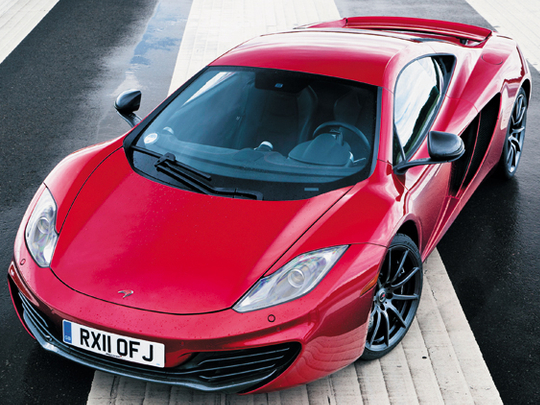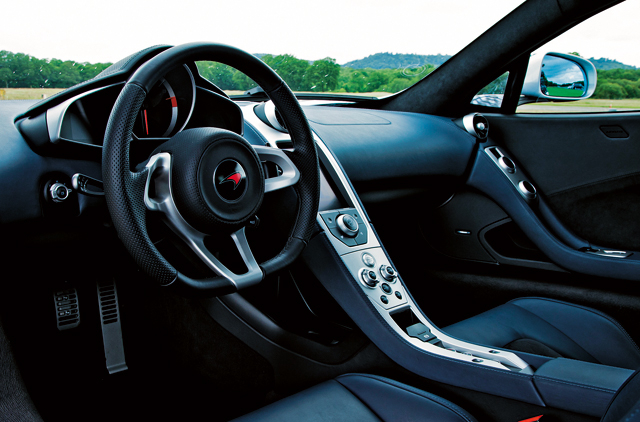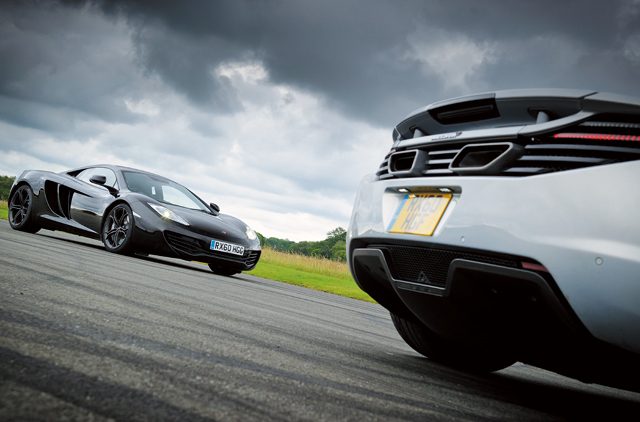
At the McLaren Technology Centre in Woking, you can't just ask for information about the tyre pressures on Mika Häkkinen's MP4-13 at the 1998 Buenos Aires Grand Prix. You'll need to be more specific than that. Which tyre? Which lap? And on which corner of the circuit? And if you think that's attention to detail, try looking for a scratched tile, a scuffed door, or a fingerprint on a stainless-steel handrail in a building occupied by more than 1,300 people. I swear I couldn't find one.
So it shouldn't surprise you to learn that the latest product of this clinically efficient organisation, the MP4-12C, is the fastest accelerating road-legal car I've ever driven; has an incredible suspension which delivers comfort, exceptional road holding and amazing traction; is the lightest car in its class; has fantastic brakes; breathes fire; can ride a unicycle; and, almost inconceivably, it has a Phd in Quantum Physics from Oxford University. Strictly speaking the last three aren't standard features, but if you ask nicely, you could probably specify them as options.
At the very heart of the MP4-12C's construction, roadholding and handling is a carbon fibre monocell weighing just 75kg. With decades of experience building CFRP race chassis, McLaren's engineers developed their own technique to create these cells, which are manufactured to an accuracy of within one millimetre, corner to corner. The tub keeps the vehicle's weight down, whilst creating an immensely strong safety cell for the occupants.
Behind them sits a twin turbocharged 3.8-litre V8, built to McLaren's specifications by Ricardo Plc in nearby West Sussex. Set low in the car thanks to its dry sump, it puts out 600Nm of torque from 3,000rpm and 592bhp at 7,000rpm. Those figures don't tell the whole story though, because only with your foot on the throttle and your head slammed back against the seat can you truly appreciate the ease with which this engine ramps up to 8,500rpm, hauling the 12C to a top speed of 330kph. In fact it takes longer to read the words "zero to one hundred kilometres an hour in three point one seconds" than it does to achieve them in the McLaren.455bhp-per-tonne will do that for you.
But we're getting ahead of ourselves here, because it's important you understand what it's like to be inside the car before you begin to explore its limits. Approaching the vehicle, you immediately notice that there are no door handles. Simply reach for the underside of the sculpted intake at the rear of the door and a touch-sensitive release mechanism allows it to open butterfly style. No handles means less weight, simpler door construction and no nasty turbulence heading toward the radiators.
Settle into the finely trimmed and supportive seat and, provided you're no taller than 1.8m, you'll find there's plenty of headroom; there's good visibility too, not just over the low-slung bonnet but surprisingly, even in the rear-view mirror.
Next take the wheel in your hands and what do you notice? That's right — nothing. Because the only function of the steering wheel in the MP4 is to turn the front wheels left and right. It doesn't control the indicators, radio, wipers or the GPS, just the front wheels. Switch on the ignition and the instruments tell the same story. A huge, easy-to-read tachometer in the centre, with simple bar-graph-type displays for oil, water and fuel-level information to the right, and white or orange text on a black background for any other data. Nothing fancy, but it gets the job done.
In fact the whole cockpit seems to have been laid out with a particular word in mind, one which I suspect is rarely used in Italy; that word is ‘subtle'. Now I love the sense of theatre which a Ferrari's manetinno brings to the steering wheel, and the dynamic instruments in an LFA could entertain me for hours, but McLaren's engineers have clearly taken an alternative approach, one which suggests that they probably have their shirts made in Jermyn Street, not Carnaby Street. Ina similar vein, the car's exterior styling has been criticised for not being aggressive or dynamic enough, yet every styling cue from the doors to the air brake, the carbon-fibre engine cover to the cooling air intakes, shouts "supercar" and if all supercars were cut from the same cloth, wouldn't the world be a dull place?
Next, please look toward the Active Dynamics Panel (centre console to you and me) where a handful of dials and buttons are the closest you'll get to fussy in the McLaren's cockpit. But for that they can be excused because the ADP is your gateway to wringing the very best out of the 12C.
On the left is the Handling mode selector and on the right, Powertrain. Set the former to Normal and the ride is supple for road use, as I tested on the appallingly maintained minor roads around Dunsfold. Potholes, ruts and speed bumps were taken comfortably in the McLaren's stride, with no bone-jarring jolts, steering histrionics or skittish behaviour. The ProActive Chassis Control is made up of interconnected hydraulic dampers (elements of which would be recognised by Citröen aficionados), honed to give a quality saloon-like ride in Normal mode, negligible body roll in Trackmode, and a Sport mode lying somewhere 'twixt the two.
With the Powertrain setting in Normal and the seven-speed Graziano-built gearbox in Auto, dawdling behind slow-moving traffic takes no particular effort, whilst the ISG (Intake Sound Generator) mutes the sound delivered to the cockpit from the intake chamber, making for a stress-free commute home to either Surbiton or Emirates Hills. That's the good news. The better news is that if you turn the Handling and Powertrain dials all the way to the right, they stop at a point marked "T". T is for Track. T is also for Tim. What a pleasant coincidence.
The track in question was laid out on the runways of Dunsfold airfield, and is best known as that used by a certain British motoring show. So how does it feel to take this remarkable car around a track recognised by millions? Well, something like this…
Right now we're powering along the bottom section of the track toward a right-hander taken whilst accelerating hard in third. "Don't back off." Through there at around 140kph and we're crossing the rough, unfinished tarmac of a disused runway. You can hear the tyres hammering over it, but there's barely a tremor in the steering wheel. Up into fourth as we hit 170kph then we're cutting left, clipping the concrete corner which causes a slight quiver through the car but again, it doesn't move even an inch right or left. "Ooh that's fast." Into fifth and there's still time to accelerate up to 220kph before it's hard on the brakes (370mm/350mm cast iron discs on aluminium hubs, though there's a carbon-ceramic option available) At these speeds the airbrake shoots up at the back of the car, creating additional drag but also rear downforce, pushing the tyres (Pirelli PZero 235/35 R19/305/30 R20)hard into the tarmac for greater traction, and helping the ProActive Dampers to keep the nose from pitching under the massive deceleration.
Now fourth gear, then immediately down into third, off the brakes and turn in, but I'm slow into the left corner and I know it. Fortunately the MP4-12C has a solution for that — 592 horsepower. Foot hard on the floor but stay in third and there's barely time to say "woohoo" before we reach my favourite corner, a tight second-gear left-hander. "Will he drift wide and then airborne?" Err, no. Not in the McLaren. Turning in is razor sharp, maybe just a fraction heavier than the LFA I drove at Yas Marina, but definitely to my liking. The negligible body roll means all four wheels stay firmly planted, then theF1-developed Brake Steer slows the inside rear wheel, turning the car tighter and eliminating high-speed understeer. The combination of phenomenal brakes and the imperceivable but effective brake steer in the corners, is enough to make an average driver think he's very good, and a good driver very, very fast.
So I fling the car left with a huge grin on my face and we're into the next section, from second, to third, to fourth in what, four seconds? In that time we've accelerated 1,430kg of car from around 100kph to 220kph. (Don't quote me, I was focused more on the next braking points than the speedo!)
All through that section, the speed at which I find myself reaching for the next gear is just breathtaking. The Graziano gearbox uses a double, wet clutch arrangement, and whilst a full click on the paddle will engage a gear apparently seamlessly, you can ‘pre-advise' the gearbox if you'll next be changing up or down, by giving the appropriate paddle a half pull in advance. Technically I'm sure it makes a difference, but to be honest I had other things on my mind, such as the intoxicating view of an airfield vanishing at warp speeds past my windscreen.
Again it's hard on the brakes, down into third and my head's thrown forwards under the tremendous stopping power, then we're sweeping left back onto the rough runway tarmac and hairing across to my least-favourite turn, a practically blind, tight right-hander taken in second somewhere around 100kph. Every time I seem to go in too fast because it's almost impossible to judge, and every time the McLaren's brake steer slings me through without a murmur. In fact it strikes me that maybe I'm better off going into every corner ‘hot', because I'm driving as though I'm in a conventional sportscar and this McLaren is a lot of things, but it's not conventional. Compelling yes, conventional no.
Now it's down the main runway, "third gear, fourth gear, fifth gear, strewth!" My adrenaline pumping due to the increased noise (the ISG allows greater levels of the engine and intake sounds to enter the cockpit in Track mode), we're already doing well over 230kph toward the tricky left-hander leading into the hairpin. Suddenly though, I realise I've messed up, because going in hot is one thing, going in overcooked is quite another. "Aargh, too fast for the left". Down through the gears, push on the brakes with all my strength, cut the left-hander to save throwing the car off balance that way, but "Nooooo…" Pity really. This would have been my fastest lap.
Even the good people of Woking have yet to conquer the laws of physics and as I tried to take the right-hand hairpin, inevitably the back end of the car broke away, so I prepared myself for a pirouette and started to throw in as much opposite lock as possible. But to my relief and, I admit, astonishment, the 12C yawed barely through 90 degrees before regaining its composure, yours truly more of a cossetted passenger for a second than the clumsy driver behind the wheel. Make no bones about it, I messed up, but the 12C spared my blushes.
McLaren Automotive may be the new boys in the low-volume sportscar market but the quality of the design and manufacture teams shines through the fabric of this car; they've definitely hit the ground running. More than 1,800 customers have already committed to buying an MP4-12C and my own experience tells me they won't be disappointed. The engineers haven't just raised the bar for supercar performance; they've taken the bar back to Woking for analysis, then built a new one that's5 per cent lighter and twice as rigid.
Specs
Model MP4-12C
Engine 3.8-litre V8 twin turbo
Transmission Seven-speed auto, RWD
Max power 592bhp @ 7,000rpm
Max torque 600Nm @ 3,000rpm
Top speed 330kph
0-100kph 3.1sec
Price Dh910,000 (expected)
Plus Incredible performance, ride quality
Minus Too nerdy, lacks character
Geek speak
The M838T engine powering the McLaren MP4-12C is a 3.8-litre twin turbo V8 unit, with custom-built turbos operating at1.2 bar and designed to give instant spool up, thus eliminating turbo lag. McLaren's goal was to give "low-level tractability, mid-range muscle and high-rev punch". Capable of revving to 8,500rpm, it has variable valve timing, allowing it to produce 80pc of its torque (600Nm) from below 2,000rpm. It also offers class-leading fuel efficiency, at 11.7 litres-per-100km.
Mated to the M838T is a dual clutch, seven-speed SSG (Seamless Shift Gearbox) transmission. Selecting between Normal, Sport and Track modes on the powertrain control alters the immediacy of gear shift, the automatic gear-change strategy and also the throttle response.
The SSG system has another trick in its box. If the driver enters a sharp corner too quickly (are you reading this Tim?), requiring a strong braking action, it's possible he/she will not be in the ideal gear for smooth acceleration out of the corner. If the left-shift control is depressed and held, instead of clicked, while under braking, the transmission automatically matches the engine speed to the correct lowest gear.
Automatic and Winter modes and Launch Control can also be selected on the central display, the latter changing all electronic functions to suit low-grip conditions and delivering maximum driver aid and support. There is no manual transmission offered; McLaren claims that the two-pedal layout offered further scope to create a narrow, lighter, and more comfortable car.














